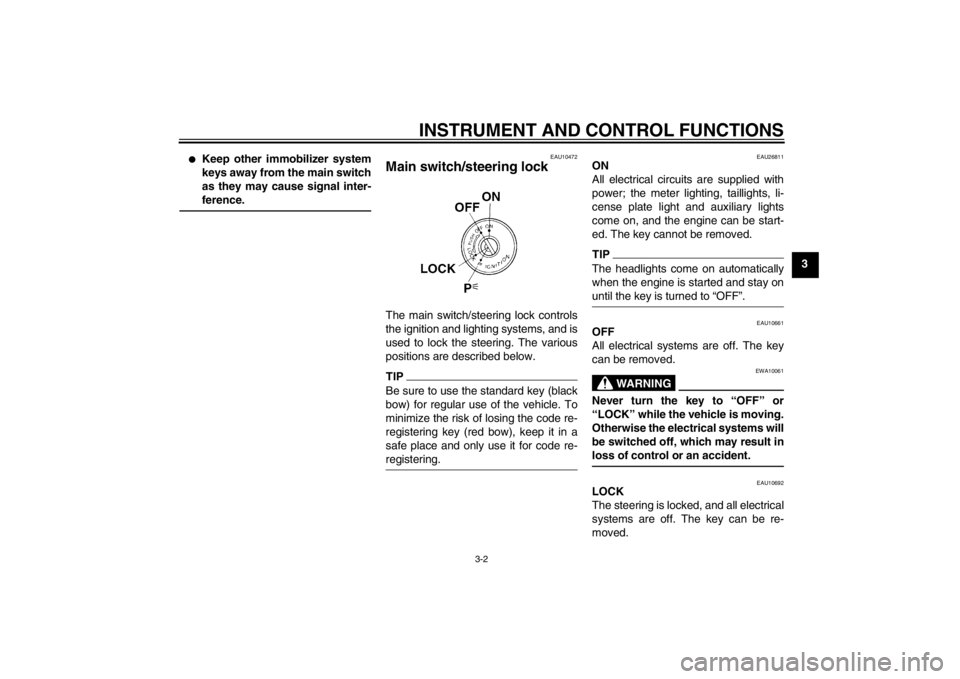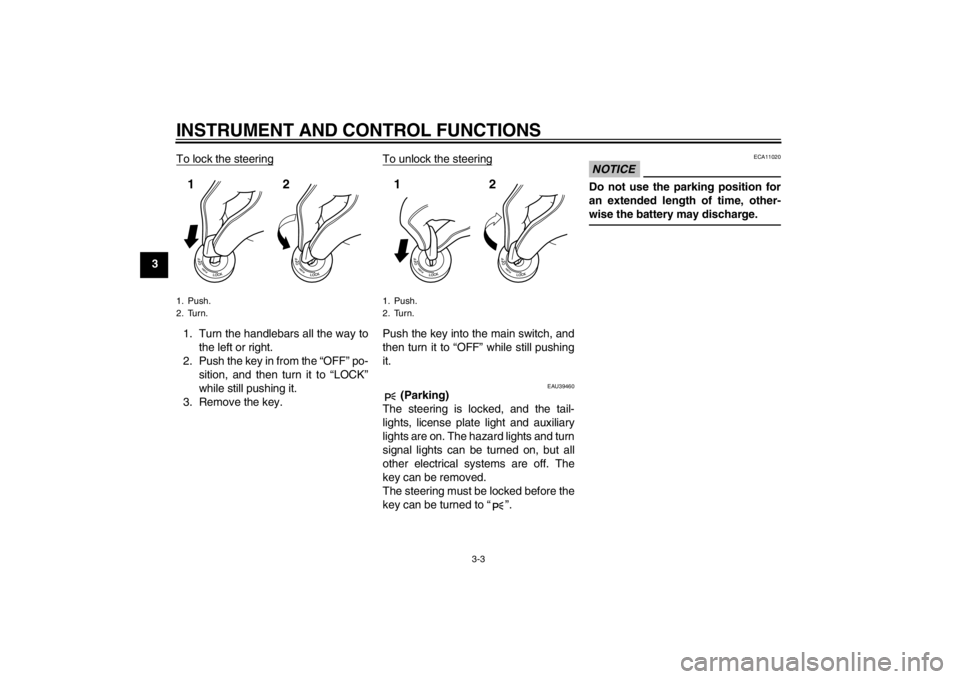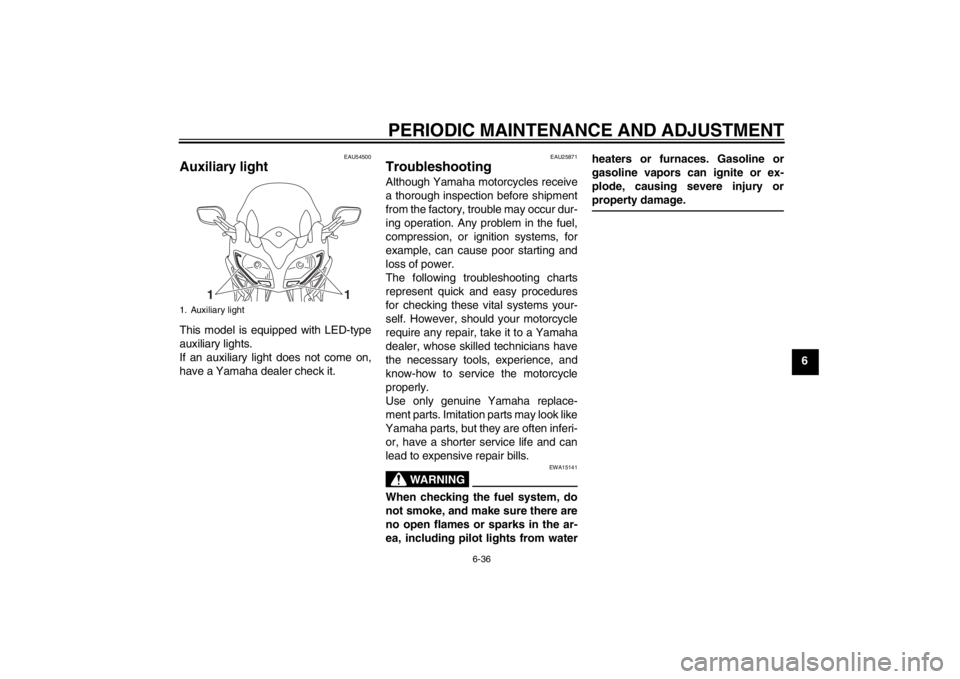AUX YAMAHA FJR1300A 2013 Owners Manual
[x] Cancel search | Manufacturer: YAMAHA, Model Year: 2013, Model line: FJR1300A, Model: YAMAHA FJR1300A 2013Pages: 118, PDF Size: 3.28 MB
Page 6 of 118

TABLE OF CONTENTSSAFETY INFORMATION ..................1-1
DESCRIPTION ..................................2-1
Left view ..........................................2-1
Right view ........................................2-2
Controls and instruments.................2-3
INSTRUMENT AND CONTROL
FUNCTIONS .......................................3-1
Immobilizer system .........................3-1
Main switch/steering lock ................3-2
Indicator lights and warning lights ............................................3-4
Cruise control system .....................3-6
Multi-function meter unit .................3-9
D-mode (drive mode) ....................3-22
Handlebar switches ......................3-23
Clutch lever ...................................3-25
Shift pedal .....................................3-25
Brake lever ...................................3-26
Brake pedal ..................................3-26
ABS ..............................................3-26
Traction control system ................3-27
Fuel tank cap ................................3-29
Fuel ...............................................3-30
Fuel tank breather/overflow
hose ..........................................3-31
Catalytic converters ......................3-31
Seats ............................................3-32
Adjusting the rider seat height ......3-33
Storage compartments .................3-35 Accessory box .............................. 3-36
Adjusting the headlight beams ..... 3-37
Handlebar position ....................... 3-37
Opening and closing the cowling
vents ......................................... 3-37
Rear view mirrors ......................... 3-39
Adjusting the front fork ................. 3-39
Adjusting the shock absorber assembly ................................... 3-41
Sidestand ..................................... 3-42
Ignition circuit cut-off system ........ 3-43
Auxiliary DC jack .......................... 3-45
FOR YOUR SAFETY –
PRE-OPERATION CHECKS ............. 4-1
OPERATION AND IMPORTANT
RIDING POINTS ................................. 5-1
Starting the engine ......................... 5-1
Shifting ........................................... 5-2
Tips for reducing fuel consumption ............................... 5-3
Engine break-in .............................. 5-3
Parking ........................................... 5-4
PERIODIC MAINTENANCE AND
ADJUSTMENT ................................... 6-1
Owner’s tool kit ............................... 6-2
Periodic maintenance chart for the emission control system ............. 6-3 General maintenance and
lubrication chart .......................... 6-4
Removing and installing panels ..... 6-8
Checking the spark plugs ............ 6-11
Engine oil and oil filter cartridge ... 6-12
Final gear oil ................................ 6-14
Coolant ........................................ 6-16
Cleaning the air filter element ...... 6-17
Checking the engine idling speed ........................................ 6-18
Checking the throttle grip free
play ........................................... 6-19
Valve clearance ........................... 6-19
Tires ............................................. 6-19
Cast wheels ................................. 6-22
Clutch lever .................................. 6-22
Checking the brake lever free play ........................................... 6-23
Brake light switches ..................... 6-23
Checking the front and rear brake pads .......................................... 6-24
Checking the brake and clutch fluid levels ................................. 6-24
Changing the brake and clutch fluids ......................................... 6-26
Checking and lubricating the
cables ....................................... 6-26
Checking and lubricating the throttle grip and cable ............... 6-26
Checking and lubricating the brake and shift pedals .............. 6-27U1MCE0E0.book Page 1 Thursday, July 19, 2012 6:59 PM
Page 7 of 118

TABLE OF CONTENTS
Checking and lubricating the brake and clutch levers ............. 6-27
Checking and lubricating the centerstand and sidestand ........ 6-28
Lubricating the rear suspension ... 6-29
Lubricating the swingarm pivots ... 6-29
Checking the front fork ................. 6-29
Checking the steering ................... 6-30
Checking the wheel bearings ....... 6-30
Battery .......................................... 6-31
Replacing the fuses ...................... 6-32
Headlight bulb .............................. 6-34
Front turn signal light .................... 6-34
Replacing a rear turn signal light
bulb or a tail/brake light bulb ..... 6-34
Replacing the license plate light bulb ........................................... 6-35
Auxiliary light ................................ 6-36
Troubleshooting ............................ 6-36
Troubleshooting charts ................. 6-37
MOTORCYCLE CARE AND
STORAGE .......................................... 7-1
Matte color caution ......................... 7-1
Care ................................................ 7-1
Storage ...........................................7-4
SPECIFICATIONS ............................. 8-1
CONSUMER INFORMATION ............. 9-1
Identification numbers .................... 9-1
U1MCE0E0.book Page 2 Thursday, July 19, 2012 6:59 PM
Page 17 of 118

INSTRUMENT AND CONTROL FUNCTIONS
3-2
3
●
Keep other immobilizer system
keys away from the main switch
as they may cause signal inter-
ference.
EAU10472
Main switch/steering lock The main switch/steering lock controls
the ignition and lighting systems, and is
used to lock the steering. The various
positions are described below.TIPBe sure to use the standard key (black
bow) for regular use of the vehicle. To
minimize the risk of losing the code re-
registering key (red bow), keep it in a
safe place and only use it for code re-
registering.
EAU26811
ON
All electrical circuits are supplied with
power; the meter lighting, taillights, li-
cense plate light and auxiliary lights
come on, and the engine can be start-
ed. The key cannot be removed.TIPThe headlights come on automatically
when the engine is started and stay on
until the key is turned to “OFF”.
EAU10661
OFF
All electrical systems are off. The key
can be removed.
WARNING
EWA10061
Never turn the key to “OFF” or
“LOCK” while the vehicle is moving.
Otherwise the electrical systems will
be switched off, which may result in
loss of control or an accident.
EAU10692
LOCK
The steering is locked, and all electrical
systems are off. The key can be re-
moved.
U1MCE0E0.book Page 2 Thursday, July 19, 2012 6:59 PM
Page 18 of 118

INSTRUMENT AND CONTROL FUNCTIONS
3-3
3To lock the steering
1. Turn the handlebars all the way to
the left or right.
2. Push the key in from the “OFF” po- sition, and then turn it to “LOCK”
while still pushing it.
3. Remove the key. To unlock the steering
Push the key into the main switch, and
then turn it to “OFF” while still pushing
it.
EAU39460
(Parking)
The steering is locked, and the tail-
lights, license plate light and auxiliary
lights are on. The hazard lights and turn
signal lights can be turned on, but all
other electrical systems are off. The
key can be removed.
The steering must be locked before the
key can be turned to “ ”.
NOTICE
ECA11020
Do not use the parking position for
an extended length of time, other-
wise the battery may discharge.
1. Push.
2. Turn.12
1. Push.
2. Turn.12
U1MCE0E0.book Page 3 Thursday, July 19, 2012 6:59 PM
Page 60 of 118

INSTRUMENT AND CONTROL FUNCTIONS
3-45
3
EAU39655
Auxiliary DC jack
WARNING
EWA14360
To prevent electrical shock or short-
circuiting, make sure that the cap is
installed when the auxiliary DC jack
is not being used.NOTICE
ECA15431
The accessory connected to the
auxiliary DC jack should not be used
with the engine turned off, and the
load must never exceed 30 W (2.5 A),
otherwise the fuse may blow or the
battery may discharge.This vehicle is equipped with an auxilia-
ry DC jack in the accessory box.
A 12-V accessory connected to the
auxiliary jack can be used when the key
is in the “ON” position and should only
be used when the engine is running.
To use the auxiliary DC jack1. Open the accessory box lid. (See page 3-36.)
2. Turn the key to “OFF”.
3. Remove the auxiliary DC jack cap. 4. Turn the accessory off.
5. Insert the accessory plug into the
auxiliary DC jack.
6. Turn the key to “ON”, and then start the engine. (See page 5-1.)
7. Turn the accessory on.
1. Auxiliary DC jack cap
1. Auxiliary DC jack
11
U1MCE0E0.book Page 45 Thursday, July 19, 2012 6:59 PM
Page 99 of 118
![YAMAHA FJR1300A 2013 Owners Manual PERIODIC MAINTENANCE AND ADJUSTMENT
6-32
6
is turned to “OFF”, then con-
nect the positive lead before
connecting the negative lead.
[ECA16840]
4. After installation, make sure that
the battery le YAMAHA FJR1300A 2013 Owners Manual PERIODIC MAINTENANCE AND ADJUSTMENT
6-32
6
is turned to “OFF”, then con-
nect the positive lead before
connecting the negative lead.
[ECA16840]
4. After installation, make sure that
the battery le](/img/51/49533/w960_49533-98.png)
PERIODIC MAINTENANCE AND ADJUSTMENT
6-32
6
is turned to “OFF”, then con-
nect the positive lead before
connecting the negative lead.
[ECA16840]
4. After installation, make sure that
the battery leads are properly con-
nected to the battery terminals.NOTICE
ECA16530
Always keep the battery charged.
Storing a discharged battery can
cause permanent battery damage.
EAU54510
Replacing the fuses The fuse boxes and individual fuses are
located under panel A. (See page 6-8.)
If a fuse is blown, replace it as follows.1. Turn the key to “OFF” and turn off the electrical circuit in question.1. Main fuse 1
2. Spare fuse
3. Cruise control fuse
4. Brake light fuse
5. Fuse box
6. Main fuse 2
5
1
3
4
2
2
5
26
1. ABS motor fuse
2. ABS solenoid fuse
3. Fuel injection system fuse
4. Backup fuse (for clock and immobilizer sys-
tem)
5. Electronic throttle valve fuse
6. Headlight fuse
7. Spare fuse
8. Hazard fuse
9. Signaling system fuse
10.Auxiliary DC jack fuse
11.ABS control unit fuse
12.Ignition fuse
13.Right radiator fan fuse
14.Left radiator fan fuse
15.Windshield motor fuse
147
9101112
13
715
817
2
3456
7
U1MCE0E0.book Page 32 Thursday, July 19, 2012 6:59 PM
Page 100 of 118

PERIODIC MAINTENANCE AND ADJUSTMENT
6-33
62. Remove the blown fuse, and then
install a new fuse of the specified
amperage. WARNING! Do not
use a fuse of a higher amperage
rating than recommended to
avoid causing extensive dam-
age to the electrical system and
possibly a fire.
[EWA15131]
3. Turn the key to “ON” and turn on the electrical circuit in question to
check if the device operates.
4. If the fuse immediately blows again, have a Yamaha dealer
check the electrical system.
Specified fuses:Main fuse 1:50.0 A
Main fuse 2: 30.0 A
Headlight fuse: 25.0 A
Brake light fuse: 1.0 A
Signaling system fuse: 10.0 A
Ignition fuse: 20.0 A
Radiator fan fuse: 10.0 A × 2
Backup fuse: 7.5 A
Hazard fuse: 7.5 A
Fuel injection system fuse: 15.0 A
ABS control unit fuse: 7.5 A
ABS motor fuse: 30.0 A
ABS solenoid fuse: 20.0 A
Cruise control fuse: 1.0 A
Auxiliary DC jack fuse: 3.0 A
Windshield motor fuse: 20.0 A
Electronic throttle valve fuse: 7.5 A
U1MCE0E0.book Page 33 Thursday, July 19, 2012 6:59 PM
Page 103 of 118

PERIODIC MAINTENANCE AND ADJUSTMENT
6-36
6
EAU54500
Auxiliary light This model is equipped with LED-type
auxiliary lights.
If an auxiliary light does not come on,
have a Yamaha dealer check it.
EAU25871
Troubleshooting Although Yamaha motorcycles receive
a thorough inspection before shipment
from the factory, trouble may occur dur-
ing operation. Any problem in the fuel,
compression, or ignition systems, for
example, can cause poor starting and
loss of power.
The following troubleshooting charts
represent quick and easy procedures
for checking these vital systems your-
self. However, should your motorcycle
require any repair, take it to a Yamaha
dealer, whose skilled technicians have
the necessary tools, experience, and
know-how to service the motorcycle
properly.
Use only genuine Yamaha replace-
ment parts. Imitation parts may look like
Yamaha parts, but they are often inferi-
or, have a shorter service life and can
lead to expensive repair bills.
WARNING
EWA15141
When checking the fuel system, do
not smoke, and make sure there are
no open flames or sparks in the ar-
ea, including pilot lights from waterheaters or furnaces. Gasoline or
gasoline vapors can ignite or ex-
plode, causing severe injury or
property damage.
1. Auxiliary light
1
1
U1MCE0E0.book Page 36 Thursday, July 19, 2012 6:59 PM
Page 113 of 118

SPECIFICATIONS
8-3
8
Rear suspension:Type:Swingarm (link suspension)
Spring/shock absorber type:
Coil spring/gas-oil damper
Wheel travel: 125.0 mm (4.92 in)Electrical system:Ignition system:
TCI
Charging system: AC magnetoBattery:Model:
GT14B-4
Voltage, capacity: 12 V, 12.0 AhHeadlight:Bulb type:
Halogen bulbBulb voltage, wattage × quantity:Headlight:
12 V, 60.0 W/55.0 W × 2
Tail/brake light:
12 V, 5.0 W/21.0 W × 2
Front turn signal light: LED
Rear turn signal light: 12 V, 21.0 W × 2
Auxiliary light:
LED
License plate light: 12 V, 5.0 W × 1 Meter lighting:
LED
Neutral indicator light: LED
High beam indicator light:
LED
Oil level warning light: LED
Turn signal indicator light: LED
Engine trouble warning light:
LED
ABS warning light: LED
Cruise control “SET” indicator light: LED
Cruise control “ON” indicator light:
LED
Immobilizer system indicator light: LED
Traction control system indicator/warning
light: LED
Fuses:Main fuse 1:
50.0 A
Main fuse 2: 30.0 A
Headlight fuse: 25.0 A
Brake light fuse:
1.0 A
Signaling system fuse: 10.0 A Ignition fuse:
20.0 A
Radiator fan fuse: 10.0 A × 2
Hazard fuse:
7.5 A
Fuel injection system fuse: 15.0 A
ABS control unit fuse: 7.5 A
ABS motor fuse:
30.0 A
ABS solenoid fuse: 20.0 A
Cruise control fuse: 1.0 A
Auxiliary DC jack fuse:
3.0 A
Backup fuse: 7.5 A
Windshield motor fuse: 20.0 A
Electronic throttle valve fuse:
7.5 A
U1MCE0E0.book Page 3 Thursday, July 19, 2012 6:59 PM
Page 115 of 118

INDEX
AABS ...................................................... 3-26
ABS warning light ................................... 3-5
Accessory box ...................................... 3-36
Air filter element, cleaning .................... 6-17
Auxiliary DC jack .................................. 3-45
Auxiliary light ........................................ 6-36BBattery .................................................. 6-31
Brake and clutch fluid levels, checking ............................................. 6-24
Brake and clutch fluids, changing ......... 6-26
Brake and clutch levers, checking and lubricating ........................................... 6-27
Brake and shift pedals, checking and
lubricating ........................................... 6-27
Brake lever ........................................... 3-26
Brake lever free play, checking ............ 6-23
Brake light switches .............................. 6-23
Brake pedal .......................................... 3-26CCables, checking and lubricating .......... 6-26
Care ........................................................ 7-1
Catalytic converters .............................. 3-31
Centerstand and sidestand, checking and lubricating .................................... 6-28
Clutch lever.................................. 3-25, 6-22
Coolant ................................................. 6-16
Cowling vents, opening and closing ..... 3-37
Cruise control indicator lights ................. 3-4
Cruise control switches ......................... 3-24
Cruise control system ............................. 3-6DDimmer/Pass switch ............................. 3-23 D-mode (drive mode) ............................ 3-22
EEngine break-in .......................................5-3
Engine idling speed, checking............... 6-18
Engine oil and oil filter cartridge ............ 6-12
Engine trouble warning light .................... 3-4FFinal gear oil.......................................... 6-14
Front and rear brake pads, checking .... 6-24
Front fork, adjusting .............................. 3-39
Front fork, checking...............................6-29
Front turn signal light............................. 6-34
Fuel ....................................................... 3-30
Fuel consumption, tips for reducing ........ 5-3
Fuel tank breather/overflow hose .......... 3-31
Fuel tank cap......................................... 3-29
Fuses, replacing .................................... 6-32HHandlebar position, adjusting ................ 3-37
Handlebar switches ............................... 3-23
Hazard switch........................................ 3-24
Headlight beams, adjusting ................... 3-37
Headlight bulb ....................................... 6-34
High beam indicator light......................... 3-4
Horn switch ........................................... 3-24IIdentification numbers ............................. 9-1
Ignition circuit cut-off system ................. 3-43
Immobilizer system .................................3-1
Immobilizer system indicator light ........... 3-6
Indicator lights and warning lights ........... 3-4LLicense plate light bulb, replacing ......... 6-35
MMain switch/steering lock ........................ 3-2
Maintenance and lubrication, periodic .... 6-4
Maintenance, emission control system ... 6-3
Matte color, caution ................................ 7-1
Menu switch .......................................... 3-24
Model label ............................................. 9-1
Multi-function meter unit ......................... 3-9NNeutral indicator light .............................. 3-4OOil level warning light .............................. 3-4PPanels, removing and installing .............. 6-8
Parking.................................................... 5-4
Part locations .......................................... 2-1RRear suspension, lubricating ................ 6-29
Rear view mirrors.................................. 3-39
Rider seat height, adjusting .................. 3-33SSafety information ................................... 1-1
Seats..................................................... 3-32
Select switch ......................................... 3-24
Shifting .................................................... 5-2
Shift pedal ............................................. 3-25
Shock absorber assembly, adjusting .... 3-41
Sidestand .............................................. 3-42
Spark plugs, checking........................... 6-11
Specifications.......................................... 8-1
Start/Engine stop switch ....................... 3-24
Starting the engine.................................. 5-1
Steering, checking ................................ 6-30
Storage ................................................... 7-4
U1MCE0E0.book Page 1 Thursday, July 19, 2012 6:59 PM